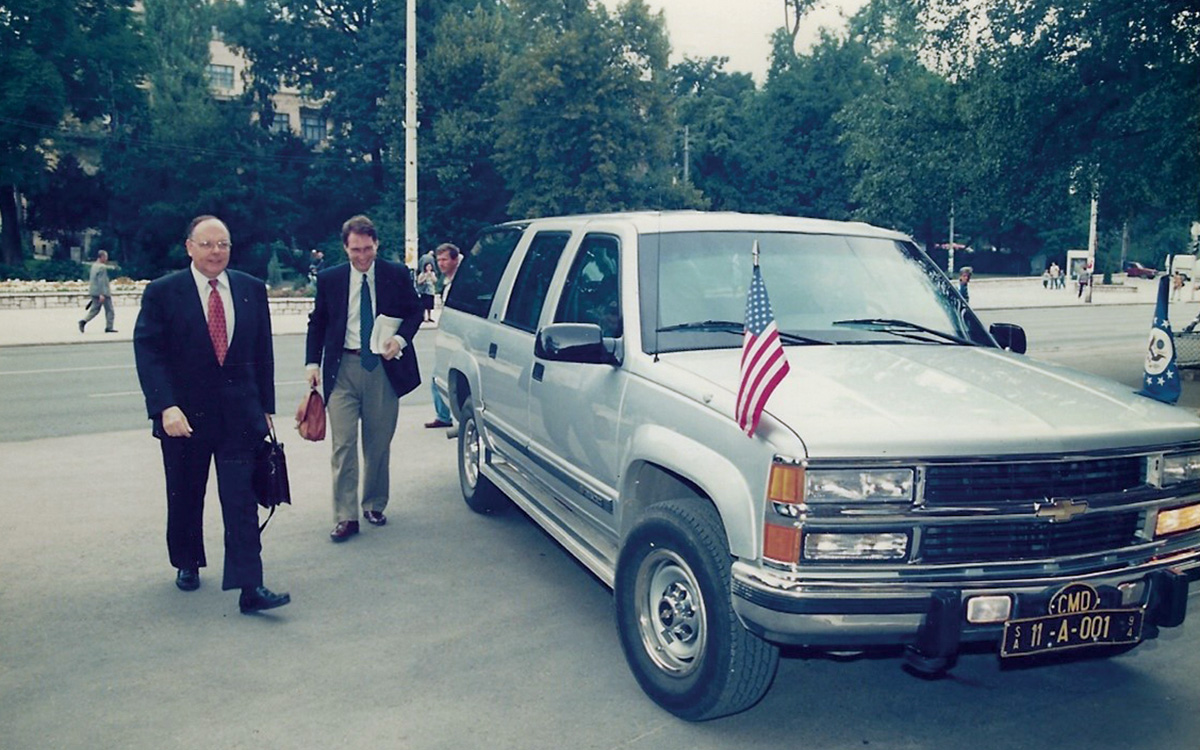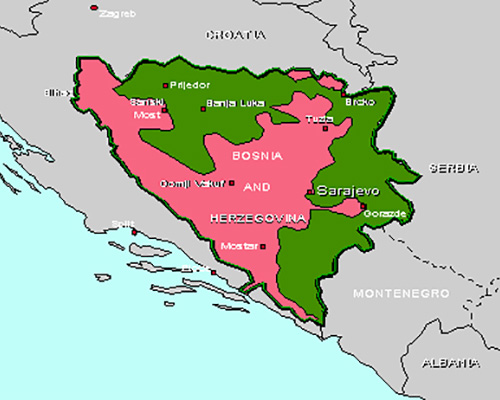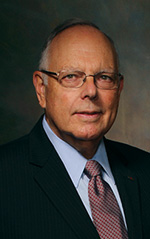Implementing Dayton: A Look Back
Reestablishing interreligious and interethnic trust, tolerance and coexistence among Serb, Croat and Bosniak proved a daunting task.
BY ROBERT M. BEECROFT

Special Envoy Robert Beecroft arriving at the Presidency Building in Sarajevo for a meeting with President Alija Izetbegovic.
Courtesy of Robert M. Beecroft
With the collapse of the Soviet Union in 1991, conflict in Europe seemed a remote possibility; but developments in the Balkans determined otherwise. From June 1991, when open warfare broke out between Croats and Serbs, until November 1995, when the General Framework Agreement for Peace in Bosnia and Herzegovina (the “Dayton Agreement” or “Dayton Accords”) was signed, the region was the setting for horrific turmoil and bloodletting—some 100,000 civilian casualties, two million internally displaced persons and international refugees, and the first act of genocide in Europe since World War II.
The events led to an unexpected change of assignment for me. While on consultation in Washington, D.C., in June 1996, I paid a courtesy call on Assistant Secretary of State for European Affairs John Kornblum, who proceeded to unleash a bolt from the blue: Balkan Special Envoy Richard Holbrooke wanted to curtail my Amman assignment and send me to Sarajevo as the special envoy and coordinator for the Bosnian Federation.
Things moved fast. I met with Holbrooke the next day. As the European Bureau’s assistant secretary in 1994-1995, he had been the driving force in U.S. efforts to end the Balkan crisis. In 1996 he was succeeded by John Kornblum, but he maintained a small office in the department, eventually serving pro bono as “Special Envoy for the Balkans.” I was to work with Bosniak (Bosnian Muslim) and Croat officials, senior military officers of the United Nations Intervention Force (IFOR) and European Union Special Envoy Carl Bildt in implementing the Dayton Agreement. I would be based at Embassy Sarajevo but report directly to Washington.
Holbrooke expressed serious concern about the viability of the shaky “Bosniak-Croat Federation” that had been cobbled together at Dayton. He described in detail the principal characters I would be dealing with. And for the next several weeks, I drank from a firehose of briefings and background information about the Balkan wars, ex-communists reborn as nationalists, powerful imams and bishops, and the deep-seated cultural tribalism in the region. Winston Churchill’s comment, “The Balkans produce more history than they can consume,” came to mind frequently.
Sarajevo, August 1996
After a quick farewell return to Amman, I proceeded to Vienna and across the Alps by Embassy Vienna vehicle to Croatia. At Zagreb airport, I checked in at the NATO dispatch office for Norwegian Air Force C-130 flight to Sarajevo, where the airport was controlled by the French military. The terminal had been shelled repeatedly and was in ruins. An armored embassy van with a Bosniak driver named Drac navigated at high speed along a four-lane street known locally as Sniper Alley. We passed block after block of shattered apartment buildings and burnt-out churches and mosques before pulling up at the Holiday Inn, a boxy, mustard-colored pile built for the 1984 Sarajevo Winter Olympics. Across Sniper Alley loomed the functional, high-rise Bosnian Parliament building, a crumbling wreck that had been one of the first targets of Serb shelling in 1992.
Like virtually every building in Sarajevo, the Holiday Inn had been shelled; but it continued to operate, thanks largely to its informal role as a convenient neutral ground for all parties. Until an alternative could be found, I would be living in a sparsely furnished room on the third floor. A single naked light bulb hung from the ceiling of my room. The elevators had not functioned in several years, so getting from the cavernous lobby to the upper floors meant navigating an uneven, rubble-strewn concrete stairway. Somehow, a dedicated hotel staff continued to produce decent meals and copious drinks. Everyone who was anyone—embassy officials, NATO, United Nations, European Union and Organization for Security and Cooperation in Europe civilians and military, nongovernmental organization (NGO) representatives, demining experts, journalists, Bosnian politicians of various ethnicities— gravitated to the Holiday Inn to drink, eat, haggle, compare notes and share gossip.
The United States had recognized Bosnia and Herzegovina (B&H) as an independent sovereign state in August 1992, at the very beginning of the war. The first American ambassador, Victor Jackovich, presented his credentials to the newly constituted Government of B&H in June 1993, but due to the shelling and sniping, Embassy Sarajevo operated from Vienna for the first year. On July 4, 1994, as the war raged on, Ambassador Jackovich formally transferred operations to Sarajevo. A 10-minute walk from the Holiday Inn, U.S. Embassy Sarajevo had been the Parliamentarians’ Club back when B&H was a constituent republic of the Socialist Federal Republic of Yugoslavia (SFRY). Today’s purpose-built U.S. embassy is several blocks away and looks out on the former Sniper Alley.
Wearing Two Hats
Following the departure for personal reasons of Amb. Jackovich’s successor in December 1996, I served as both U.S. special envoy for the Bosnian Federation and Embassy Sarajevo chargé d’affaires until September 1997. Separating the two functions was a challenge at times.
As Federation special envoy I mostly freelanced, based on the situation on the ground. What instructions I did receive were mostly informal—phone conversations with John Kornblum, drop-in visits from Dick Holbrooke and his team and quick trips to Vienna to confer with U.S. Ambassador Swanee Hunt. My mandate was to engage with a wide range of Bosniak and Croat government, religious, cultural, educational and media figures and seek ways to strengthen the stability and effectiveness of the Bosniak-Croat Federation (“entity”) within B&H. I had no mandate to deal with the Serbs in their separate entity, Republika Srpska.
As Federation special envoy I mostly freelanced, based on the situation on the ground. … My mandate was to engage with a wide range of Bosniak and Croat government, religious, cultural, educational and media figures.
As embassy chargé, on the other hand, I received instructions through normal State Department channels. My responsibilities covered U.S. diplomatic operations throughout the entire country—the Federation, Republika Srpska and Brcko District—including monitoring compliance with Dayton provisions at the state, entity and municipal levels. This was a complex effort that focused on the three “constituent peoples” of Bosnia, as defined by Dayton: Bosniaks, Croats and Serbs. In addition to the citizens of B&H, my team and I engaged with a broad range of international players, including the Office of the High Representative, OSCE, E.U., NATO, the U.N. Stabilization Force (SFOR, the successor to IFOR) and the media.
I made it a point to visit OHR headquarters frequently, both to exchange information and, where possible, to coordinate our efforts and avoid misunderstandings. The Dayton Agreement had specified that “in view of the complexities,” a “High Representative” be designated to facilitate implementation of the settlement. Carl Bildt was the natural choice. He had become prime minister of Sweden in 1991 at the age of 42, and in 1994 the European Union appointed him E.U. Special Envoy to the Former Yugoslavia. Bildt brought to the job an air of quiet authority, a subtle and probing intellect, an encyclopedic knowledge of world and European history, and a thorough understanding of the issues and personalities in B&H and the region. In early 1996, along with a small and dedicated international staff, he began OHR operations inside a former bank building in the heart of Sarajevo. (It is no coincidence that the flag of Bosnia and Herzegovina is blue and yellow, like the flag of Sweden: it was designed by Carl Bildt.)
In response to the U.N.’s failure to keep the peace in B&H and prevent genocide at Srebrenica, Dick Holbrooke took steps to minimize the organization’s role. The High Representative received formal political guidance not from the U.N. but from an 11-member steering board of the Peace Implementation Council, consisting of Canada, France, Germany, Italy, Japan, Russia, United Kingdom, United States, the presidency of the European Union, the European Commission and the Organization of the Islamic Conference, represented by Turkey. Informal consultations between the High Representative and individual states also took place on a regular basis. This arrangement gave Bildt and his successors unusual flexibility and autonomy.
OHR’s mandate and priorities often differed from mine. OHR focused on the multiple challenges of “state-building” throughout B&H in all its dimensions—political, economic and social. By contrast, my role as special envoy was limited to the Bosniak-Croat Federation. As embassy chargé d’affaires, I would sometimes have to carry the bad news to Bildt that Washington disagreed with the High Rep’s position on one or another issue.
Tribes and Tribalism
Newcomers to the Balkans are invariably struck by the powerful influence of “national”—i.e., tribal—identity. The Slavic languages make a clear distinction between liudi (people) and narodi (peoples). At Dayton, American and European negotiators dealt with this individual-versus-tribe tension by designating the Bosniaks, Croats and Serbs as the three “constituent peoples” of Bosnia and Herzegovina. The underlying hope was that with the passage of time, passions would eventually subside, and human relations could return to something approximating the Yugoslav era, with its interethnic marriages and highly successful 1984 Winter Olympic Games. It would not be easy.
To complicate matters further, Dayton’s “constituent peoples” formula did a serious disservice to B&H citizens who do not fit the template. The Dayton Accords lump together Bosnia’s Jews, Roma, Hungarians, Italians, Slovenes, Montenegrins, Albanians, and so forth, as “others” (ostali). By deliberate omission, these “others” are ineligible to hold several high government offices, most importantly the three-headed B&H presidency. In 2009, two Bosnians—Dervo Sejdic, a Roma, and Jakob Finci, president of the Jewish community—challenged this in the European Court of Human Rights. The court ruled in their favor, but more than a decade later, the B&H Parliament still has not agreed to constitutional reforms proposed in 2011 that would have rectified the situation.
In designating Bosniaks, Croats and Serbs as the “most equal” inhabitants of B&H, the Dayton negotiators bowed to geopolitical reality. Bosnia’s Serbs and Croats could depend on the moral and material support of their ethnoreligious cousins next door in Serbia and Croatia. Bosniaks did not have this option. At Dayton, this basic fact was present in the flesh for all to see. The only party to the talks who actually came from B&H was the Bosniak representative, Alija Izetbegovic. Two individuals who were not citizens of Bosnia and Herzegovina represented their respective B&H “peoples” in the talks—President Slobodan Milosevic of Serbia and President Franjo Tudjman of Croatia.
In early 1997 Assistant Secretary Kornblum instructed me to seek a private meeting with the chair of the Federal Presidency, Alija Izetbegovic. I was to express Washington’s concern that a full year after the end of the war, an unspecified number of “foreign fighters” continued to live in remote villages inside the Federation, some with their families. Most had traveled to B&H from the Middle East and North Africa in 1993 and 1994 and called themselves mujahideen.
Still more troubling, ethnic grievances and resentments are reasserting themselves inside the country, particularly in the Republika Srpska.
The presidency building in Sarajevo is a massive Austro-Hungarian structure that would not be out of place on the Ring in Vienna. My armored van pulled up to the portico, and Bosnian Protocol, which continued to operate in the best Austro-Hungarian tradition, escorted me to the president’s office. At the age of 71, Izetbegovic (1925-2003) had achieved legendary status as a hero or a villain, depending on one’s ethnic affiliation and political leanings. In 1970 he published an “Islamic Declaration,” which Yugoslav authorities quickly banned. He spent five years during the 1980s in a Yugoslav prison for “hostile activity inspired by Bosnian nationalism.” We had met before, but this was my first formal démarche to him. After welcoming me to his imposing office and shaking hands, he slumped down on a sofa and gestured for me to sit in a chair on the other side of the coffee table. He looked worn and tired, his rumpled brown suit too big for his shrunken frame; but his gaze was piercing. We spoke English.
An iconic photograph, taken at Wright-Patterson Air Force Base on Nov. 21, 1995, shows President Izetbegovic, flanked by Serbia’s Milosevic, Croatia’s Tudjman and Secretary of State Warren Christopher initialing the Dayton document, which they formally signed in Paris three weeks later. I reminded Izetbegovic of that historic event and his commitment to Dayton, specifically to Article III, Paragraph 2 of Annex 1A: “all foreign Forces, including individual advisors, freedom fighters, trainers, volunteers, and personnel from neighboring and other States, shall be withdrawn from the territory of Bosnia and Herzegovina.” I asked him how soon, and by what means, would foreign fighters still in B&H leave the country. Going beyond my instructions, I threw in a sweetener: As a co-signatory of Dayton, the United States would be prepared to facilitate their departure as necessary and appropriate.
The president shrank further into the sofa, lost in thought. Finally, he looked up and shook his head: “I have a blood debt to these people. They came to the rescue of the Bosniaks when Europeans and Americans did not.” He assured me that he was aware of the commitment he had made at Dayton but would not take an active role in the apprehension or expulsion of foreign fighters from B&H. I took this to mean that he would not lift a finger himself but would not intervene to oppose efforts by other Dayton signatories, including the United States. It was a characteristically Balkan way of transferring responsibility to outsiders who could be blamed later if necessary. Bosnians of all ethnicities would have understood his gambit. I reported the conversation in detail to Washington, which chose not to press the matter further in diplomatic channels.
I also had several pleasant conversations with the Grand Mufti of Bosnia and Herzegovina, Mustafa Ceric, at his headquarters adjoining the beautiful Emperor’s Mosque, built in 1457 after the Ottoman conquest of Sarajevo, and facing the Miljacka River. Nearby is the so-called Latin Bridge over the Miljacka, where Archduke Franz Ferdinand was assassinated in 1914.
When speaking with Americans, Ceric regularly stressed what he considered two fundamental points concerning the future viability of B&H: 1) Bosniaks are both Muslims and Europeans, and see no contradiction between the two; 2) Bosniaks, Croats and Serbs coexisted peacefully for centuries, and the goal now was to reestablish an interreligious relationship of trust, tolerance and coexistence. In 2012 Ceric left his post as Grand Mufti, and later ran unsuccessfully to become the Bosniak member of the three-member co-presidency of B&H. He is now president of the World Bosniak Congress.
… and the Croats

Bosnia and Herzegovina, according to the Dayton Agreement. Green shows Bosnian Serb territory, and pink shows Bosnian Federation territory.
Courtesy of Robert M. Beecroft
The overwhelmingly Roman Catholic Croats are the least numerous of Bosnia and Herzegovina’s three “constituent peoples.” In 1997 Bosniak political and moral power and authority unquestionably rested with Izetbegovic, but no single Croat politician could claim similar authority over the Croat “nation.” While the country’s Bosniak population tends to concentrate in well-defined urban areas (e.g., Sarajevo, Tuzla, Gorazde, Zenica, Bihac), most Croats live in smaller settlements along the lengthy Bosnian-Croatian border, with other pockets in the country’s center, such as the mountain towns of Jajce and Fojnica.
B&H Croat leaders, with encouragement and material support from Zagreb, had declared their own unrecognized statelet of “Herceg-Bosna” in 1991, with its de facto capital in West Mostar. (East Mostar remained under Bosniak control throughout the war.) Croat shelling in 1993 destroyed the historic 16th-century Stari Most, or “Old Bridge,” over the Neretva River between East and West Mostar—a graceful structure commissioned by Suleiman the Magnificent in 1557. The bridge has been rebuilt by French engineers, using stones from the original quarry.
Kresimir Zubak was president of Herceg-Bosna from 1994 until the ministate’s official disappearance in 1996. Zubak quickly became active in Bosnian politics, serving as the first president of the Federation and, from 1996 to 1998, as the Croat member of the tripartite B&H presidency. My dealings with Zubak were civil and correct, but hardly warm. He was reserved, calculating and cautious, visibly measuring the impact on the Croat minority and his own political standing of any move the internationals might be considering. He also remained in close contact with Croatia’s President Tudjman in Zagreb, who strongly influenced Croat policy on both sides of the border. There would be no breakthroughs with Zubak.
Jadranko Prlic was a more receptive Croat interlocutor. After serving early in the war as prime minister of Herceg-Bosna, he was Federation defense minister during “Operation Storm,” a tide-turning Croat-Bosniak offensive in mid-1995 that inflicted the first significant military defeat on Serb forces in B&H. He then became the first foreign minister of B&H, remaining in that post from 1996 until 2001. In 2013 the International Criminal Tribunal for the Former Yugoslavia indicted Prlic for alleged war crimes against Bosniaks and sentenced him to 25 years in prison. The judgment was upheld by an appeals court in 2017.
I also met several times with Franjo Komarica, the bishop of Banja Luka. He was an erudite and thoughtful man, and his distress at the expulsion of his parishioners from the Posavina region of R.S. was intense. By contrast, the Bishop of Mostar, Ratko Peric, rejected without explanation all requests for meetings with international officials. I eventually took advantage of a brief trip to Rome to convey my displeasure directly to a senior member of the Vatican Secretariat of State. He expressed awareness and disapproval of Bishop Peric’s behavior, as well as the Holy See’s reluctance to take action against him. He referred me to church officials in Zagreb, with whom I later had interesting and frank conversations.
Too Much History Per Capita
I returned to Washington at the end of August 1997, handing over the reins in Sarajevo to Ambassador Richard Kauzlarich. Washington did not appoint a successor as special envoy. The consensus seemed to be that Dayton had succeeded in establishing a new, if complex, political reality in B&H. At the time, I did not suspect that I would be returning to Sarajevo four years later as head of the largest OSCE operation in the world, with 800 civilian and military personnel, four regional centers and 24 field offices throughout the country. Along with two loyal and experienced deputies, French Ambassador Henri Zipper de Fabiani and Russian Ambassador Viktor Tkachenko, I spent the period between 2001 and 2004 focusing on the conduct of elections, reform of the judicial system, education reform, media freedom and good governance in B&H.
Today, ethnic politicians and their political parties in Bosnia and Herzegovina continue to dominate the political and economic scene. Sadly, they show little interest in grooming a successor generation of leaders, much less handing over power to it. The brain drain of young Bosnians of all groups has accelerated, as the best and brightest leave the country and the Balkan region for opportunities in western Europe, the United States, Canada and Australia. The economy is stagnant, uncoordinated and corrupt. Elsewhere in the neighborhood, Croatia and Slovenia have become E.U. members and NATO Allies; Montenegro has joined NATO; and even Serbia toys with the prospect of eventual E.U. and NATO membership. But Bosnia and Herzegovina is stuck.
Still more troubling, ethnic grievances and resentments are reasserting themselves inside the country, particularly in the Republika Srpska entity of B&H. Two decades ago, Milorad Dodik was seen by the internationals in Sarajevo (including me) as a young, promising Serb political figure. Today, as president of Republika Srpska, Dodik persistently undermines the ineffective Sarajevo central government and looks to Moscow for support.
In 1888 Otto von Bismarck mused: “One day, the great European War will come out of some damned foolish thing in the Balkans.” In the 20th century, his prophesy came true, not once but twice. If Bismarck is to be proven wrong in the 21st century, we need to pay serious attention to Balkan affairs, now and in the future. To take no meaningful and effective action as Bosnia and Herzegovina continues its slow downward tailspin is a recipe for eventual crisis. As in the 1990s, the United States will not escape involvement.
Read More...
- “Decision to Intervene: How the War in Bosnia Ended,” by Ivo H. Daadler, The Foreign Service Journal, December 1998
- “Tito’s Yugoslavia: Simmering Signs of Ethnic Tension,” by J. Chapman Chester, The Foreign Service Journal, April 2020
- “The Dayton Peace Accords,” Yale Law School




